Pollution Characteristics and Source Apportionment of Black Carbon Aerosols during Spring in Beijing
Abstract
:1. Introduction
2. Materials and Methods
2.1. Study Region and Data Collection
2.2. Black Carbon Measurements
2.3. PSCF and CWT Models
3. Results and Discussion
3.1. Light Absorption Characteristics
3.2. BC Concentration Characteristics
3.3. The Relationship between BC and Air Pollutants
3.4. Analysis of Potential Pollution Sources Region of BC
3.4.1. Potential Source Regions of BC in Spring
3.4.2. Study on the Influence of Spring Dust Weather on BC in Beijing
4. Conclusions
Supplementary Materials
Author Contributions
Funding
Institutional Review Board Statement
Informed Consent Statement
Data Availability Statement
Acknowledgments
Conflicts of Interest
References
- Lelieveld, J.; Evans, J.S.; Fnais, M.; Giannadaki, D.; Pozzer, A. The contribution of outdoor air pollution sources to premature mortality on a global scale. Nature 2015, 525, 367–371. [Google Scholar] [CrossRef] [PubMed]
- Lave, L.B.; Seskin, E.P. Air Pollution and Human Health; Taylor and Francis: Boca Raton, FL, USA, 2013. [Google Scholar]
- Bond, T.C.; Doherty, S.J.; Fahey, D.W.; Forster, P.M.; Berntsen, T.; DeAngelo, B.J.; Flanner, M.G.; Ghan, S.; Kärcher, B.; Koch, D.; et al. Bounding the role of black carbon in the climate system: A scientific assessment. J. Geophys. Res.-Atmos. 2013, 118, 5380–5552. [Google Scholar] [CrossRef]
- Chen, W.; Tian, H.M.; Zhao, H.M.; Qin, K. Multichannel characteristics of absorbing aerosols in Xuzhou and implication of black carbon. Sci. Total Environ. 2020, 714, 136820. [Google Scholar] [CrossRef]
- Laeremans, M.; Dons, E.; Avila-Palencia, I.; Carrasco-Turigas, G.; Orjuela-Mendoza, J.P.; Anaya-Boig, E.; Cole-Hunter, T.; De Nazelle, A.; Nieuwenhuijsen, M.; Standaert, A.; et al. Black Carbon Reduces the Beneficial Effect of Physical Activity on Lung Function. Med. Sci. Sport. Exer. 2018, 50, 1875–1881. [Google Scholar] [CrossRef]
- Lai, C.H.; Lin, C.H.; Liao, C.C. Respiratory deposition and health risk of inhalation of particle-bound heavy metals in the carbon black feeding area of a tire manufacturer. Air Qual. Atmos. Health 2017, 10, 1281–1289. [Google Scholar] [CrossRef]
- Louwies, T.; Nawrot, T.; Cox, B.; Dons, E.; Penders, J.; Provost, E.; Panis, L.I.; De Boever, P. Blood pressure changes in association with black carbon exposure in a panel of healthy adults are independent of retinal microcirculation. Environ. Int. 2015, 75, 81–86. [Google Scholar] [CrossRef]
- Huang, R.J.; Yang, L.; Cao, J.J.; Chen, Y.; Chen, Q.; Li, Y.J.; Duan, J.; Zhu, C.S.; Dai, W.T.; Wang, K.; et al. Brown Carbon Aerosol in Urban Xi’an, Northwest China: The Composition and Light Absorption Properties. Environ. Sci. Technol. 2018, 52, 6825–6833. [Google Scholar] [CrossRef] [PubMed]
- Peralta, O.; Ortínez-Alvarez, A.; Basaldud, R.; Santiago, N.; Alvarez-Ospina, H.; de la Cruz, K.; Barrera, V.; Espinosa, M.D.; Saavedra, I.; Castro, T.; et al. Atmospheric black carbon concentrations in Mexico. Atmos. Res. 2019, 230, 104626. [Google Scholar] [CrossRef]
- Barman, N.; Gokhale, S. Urban black carbon-source apportionment, emissions and long-range transport over the Brahmaputra River Valley. Sci. Total Environ. 2019, 693, 133577. [Google Scholar] [CrossRef]
- Li, X.R.; Sun, N.N.; Jin, Q.H.; Zhao, Z.Y.; Wang, L.L.; Wang, Q.L.; Gu, X.; Li, Y.X.; Liu, X.A. Light absorption properties of black and brown carbon in winter over the North China Plain: Impacts of regional biomass burning. Atmos. Environ. 2022, 278, 119100. [Google Scholar] [CrossRef]
- Lou, S.J.; Yang, Y.; Wang, H.L.; Smith, S.J.; Qian, Y.; Rasch, P.J. Black Carbon Amplifies Haze Over the North China Plain by Weakening the East Asian Winter Monsoon. Geophys. Res. Lett. 2019, 46, 452–460. [Google Scholar] [CrossRef]
- Liu, Q.Y.; Ma, T.M.; Olson, M.R.; Liu, Y.J.; Zhang, T.T.; Wu, Y.; Schauer, J.J. Temporal variations of black carbon during haze and non-haze days in Beijing. Sci. Rep. 2016, 6, 33331. [Google Scholar] [CrossRef]
- Wang, H.Q.; He, Q.S.; Chen, Y.H.; Kang, Y.M. Characterization of black carbon concentrations of haze with different intensities in Shanghai by a three-year field measurement. Atmos. Environ. 2014, 99, 536–545. [Google Scholar] [CrossRef]
- Huang, G.; Liu, W.; Liu, Z.H.; Zhang, Y. A Research Overview of Black Carbon Aerosols. J. Catastrophology 2015, 30, 205–214. (In Chinese) [Google Scholar]
- Yang, Y.; Wang, H.L.; Smith, S.J.; Ma, P.L.; Rasch, P.J. Source attribution of black carbon and its direct radiative forcing in China. Atmos. Chem. Phys. 2017, 17, 4319–4336. [Google Scholar] [CrossRef]
- Liu, Y.; Yan, C.Q.; Zheng, M. Source apportionment of black carbon during winter in Beijing. Sci. Total Environ. 2018, 618, 531–541. [Google Scholar] [CrossRef] [PubMed]
- Jing, A.K.; Zhu, B.; Wang, H.L.; Yu, X.N.; An, J.L.; Kang, H. Source apportionment of black carbon in different seasons in the northern suburb of Nanjing, China. Atmos. Environ. 2019, 201, 190–200. [Google Scholar] [CrossRef]
- Yang, Y.; Zhao, D.L.; Huang, Y.; Tian, P.; Liu, D.T.; Huang, M.Y.; He, H.; Ding, D.P.; Li, Y.Y.; Zhao, C. Effects of black carbon aerosol on air quality and vertical meteorological factors in early summer in Beijing. Sci. Total Environ. 2022, 847, 157529. [Google Scholar] [CrossRef]
- Zhang, Q.; Streets, D.G.; Carmichael, G.R.; He, K.B.; Huo, H.; Kannari, A.; Klimont, Z.; Park, I.S.; Reddy, S.; Fu, J.S.; et al. Asian emissions in 2006 for the NASA INTEX-B mission. Atmos. Chem. Phys. 2009, 9, 5131–5153. [Google Scholar] [CrossRef]
- Hsu, Y.K.; Holsen, T.M.; Hopke, P.K. Comparison of hybrid receptor models to locate PCB sources in Chicago. Atmos. Environ. 2003, 37, 545–562. [Google Scholar] [CrossRef]
- Chen, P.F.; Kang, S.C.; Gan, Q.Y.; Yu, Y.; Yuan, X.L.; Liu, Y.J.; Tripathee, L.; Wang, X.X.; Li, C.L. Concentrations and light absorption properties of PM2.5 organic and black carbon based on online measurements in Lanzhou, China. J. Environ. Sci. 2023, 131, 84–95. [Google Scholar] [CrossRef] [PubMed]
- Liakakou, E.; Stavroulas, I.; Kaskaoutis, D.G.; Grivas, G.; Paraskevopoulou, D.; Dumka, U.C.; Tsagkaraki, M.; Bougiatioti, A.; Oikonomou, K.; Sciare, J.; et al. Long-term variability, source apportionment and spectral properties of black carbon at an urban background site in Athens, Greece. Atmos. Environ. 2020, 222, 117137. [Google Scholar] [CrossRef]
- Xie, C.H.; Xu, W.Q.; Wang, J.F.; Wang, Q.Q.; Liu, D.T.; Tang, G.Q.; Chen, P.; Du, W.; Zhao, J.; Zhang, Y.J.; et al. Vertical characterization of aerosol optical properties and brown carbon in winter in urban Beijing, China. Atmos. Chem. Phys. 2019, 19, 165–179. [Google Scholar] [CrossRef]
- Lack, D.A.; Langridge, J.M.; Bahreini, R.; Cappa, C.D.; Middlebrook, A.M.; Schwarz, J.P. Brown carbon and internal mixing in biomass burning particles. Proc. Natl. Acad. Sci. USA 2012, 109, 14802–14807. [Google Scholar] [CrossRef] [PubMed]
- Li, S.; Zhu, M.; Yang, W.Q.; Tang, M.J.; Huang, X.L.; Yu, Y.G.; Fang, H.; Yu, X.; Yu, Q.Q.; Fu, X.X.; et al. Filter-based measurement of light absorption by brown carbon in PM in a megacity in South China. Sci. Total Environ. 2018, 633, 1360–1369. [Google Scholar] [CrossRef] [PubMed]
- Yang, X.-M.; Shi, S.-S.; Zhang, C.; Wang, H.-L.; Wang, Z.-B.; Zhu, B. Temporal Evolution and Main Influencing Factors of Black Carbon Aerosol in Nanjing. Environ. Sci. 2020, 41, 620–629. (In Chinese) [Google Scholar]
- Chen, Y.; Zhang, S.M.; Peng, C.; Shi, G.M.; Tian, M.; Huang, R.J.; Guo, D.M.; Wang, H.B.; Yao, X.J.; Yang, F.M. Impact of the COVID-19 pandemic and control measures on air quality and aerosol light absorption in Southwestern China. Sci. Total Environ. 2020, 749, 141419. [Google Scholar] [CrossRef]
- Sharma, M.C.; Pandey, V.K.; Kumar, R.; Latief, S.U.; Chakrawarthy, E.; Acharya, P. Seasonal characteristics of black carbon aerosol mass concentrations and influence of meteorology, New Delhi (India). Urban. Clim. 2018, 24, 968–981. [Google Scholar] [CrossRef]
- Kumar, R.R.; Soni, V.K.; Jain, M.K. Evaluation of spatial and temporal heterogeneity of black carbon aerosol mass concentration over India using three year measurements from IMD BC observation network. Sci. Total Environ. 2020, 723, 138060. [Google Scholar] [CrossRef]
- Chen, W.; Tian, H.M.; Qin, K. Black Carbon Aerosol in the Industrial City of Xuzhou, China: Temporal Characteristics and Source Appointment. Aerosol Air Qual. Res. 2019, 19, 794–811. [Google Scholar] [CrossRef]
- Williams, M.A.; Kumar, T.V.L.; Rao, D.N. Characterizing black carbon aerosols in relation to atmospheric boundary layer height during wet removal processes over a semi urban location. J. Atmos. Sol.-Terr. Phys. 2019, 182, 165–176. [Google Scholar] [CrossRef]
- Xiao, S.H.; Yu, X.N.; Zhu, B.; Kumar, K.R.; Li, M.; Li, L. Characterization and source apportionment of black carbon aerosol in the Nanjing Jiangbei New Area based on two years of measurements from Aethalometer. J. Aerosol Sci. 2020, 139, 105461. [Google Scholar] [CrossRef]
- Bibi, S.; Alam, K.; Chishtie, F.; Bibi, H.; Rahman, S. Temporal variation of Black Carbon concentration using Aethalometer observations and its relationships with meteorological variables in Karachi, Pakistan. J. Atmos. Sol.-Terr. Phys. 2017, 157, 67–77. [Google Scholar] [CrossRef]
- Fang, D.; Yang, J. Drivers and critical supply chain paths of black carbon emission: A structural path decomposition. J. Environ. Manag. 2021, 278, 111514. [Google Scholar] [CrossRef]
- Song, W.W.; He, K.B.; Lei, Y. Black carbon emissions from on-road vehicles in China, 1990–2030. Atmos. Environ. 2012, 51, 320–328. [Google Scholar] [CrossRef]
- Wang, Y.X.; Wang, X.; Kondo, Y.; Kajino, M.; Munger, J.W.; Hao, J.M. Black carbon and its correlation with trace gases at a rural site in Beijing: Top-down constraints from ambient measurements on bottom-up emissions. J. Geophys. Res.-Atmos. 2011, 116, D2430. [Google Scholar] [CrossRef]
- Streets, D.G.; Yarber, K.F.; Woo, J.H.; Carmichael, G.R. Biomass burning in Asia: Annual and seasonal estimates and atmospheric emissions. Glob. Biogeochem. Cycles 2003, 17, 1099. [Google Scholar] [CrossRef]
- Duan, F.K.; He, K.B.; Ma, Y.L.; Jia, Y.T.; Yang, F.M.; Lei, Y.; Tanaka, S.; Okuta, T. Characteristics of carbonaceous aerosols in Beijing, China. Chemosphere 2005, 60, 355–364. [Google Scholar] [CrossRef] [PubMed]
- Tan, Y.; Wang, H.L.; Zhu, B.; Zhao, T.L.; Shi, S.S.; Liu, A.K.; Liu, D.Y.; Pan, C.; Cao, L. The interaction between black carbon and planetary boundary layer in the Yangtze River Delta from 2015 to 2020: Why O3 didn’t decline so significantly as PM2.5. Environ. Res. 2022, 214, 114095. [Google Scholar] [CrossRef]
- Chen, S.; Zhao, D.; Huang, J.; He, J.; Chen, Y.; Chen, J.; Bi, H.; Lou, G.; Du, S.; Zhang, Y.; et al. Mongolia Contributed More than 42% of the Dust Concentrations in Northern China in March and April 2023. Adv. Atmos. Sci. 2023, 40, 1549–1557. [Google Scholar] [CrossRef]
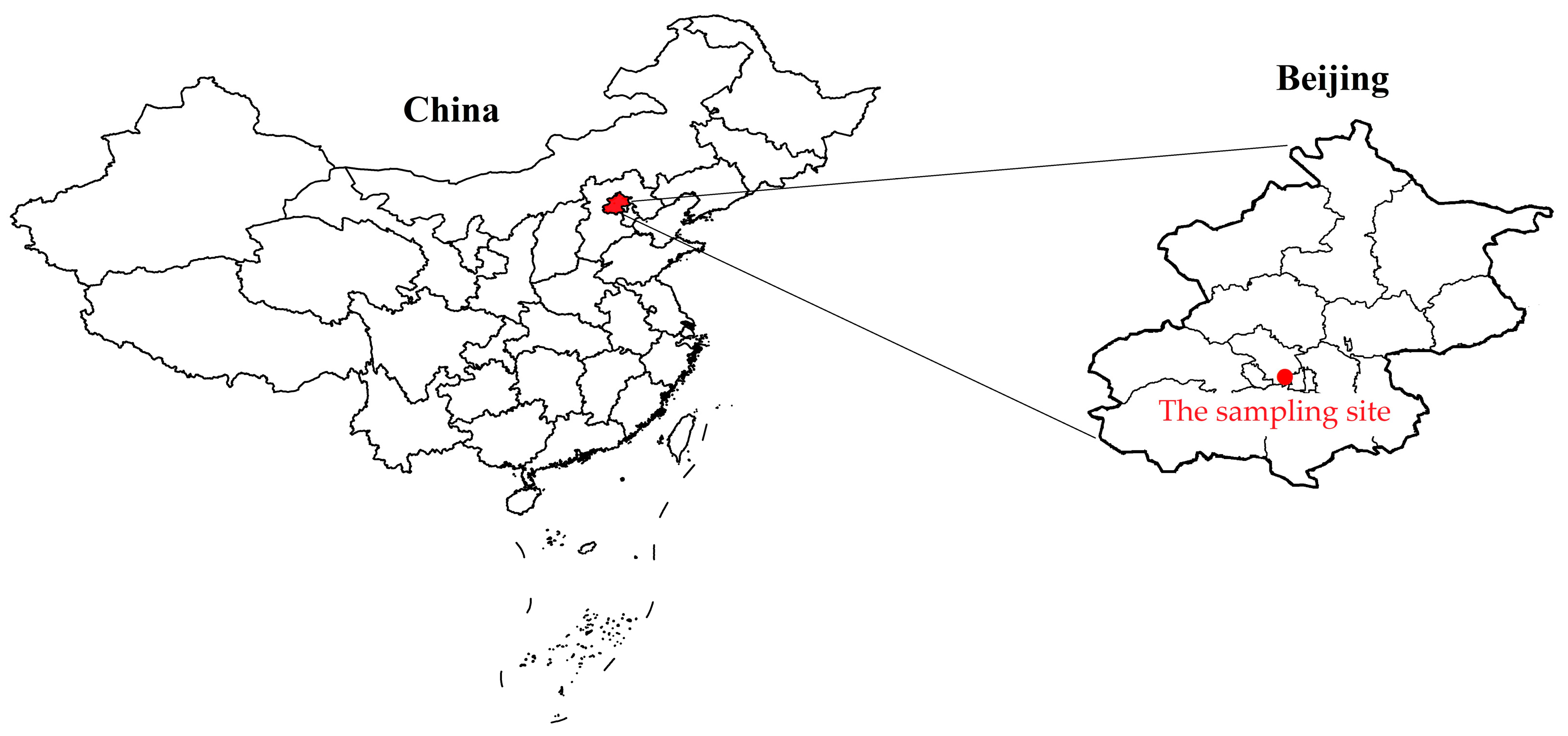

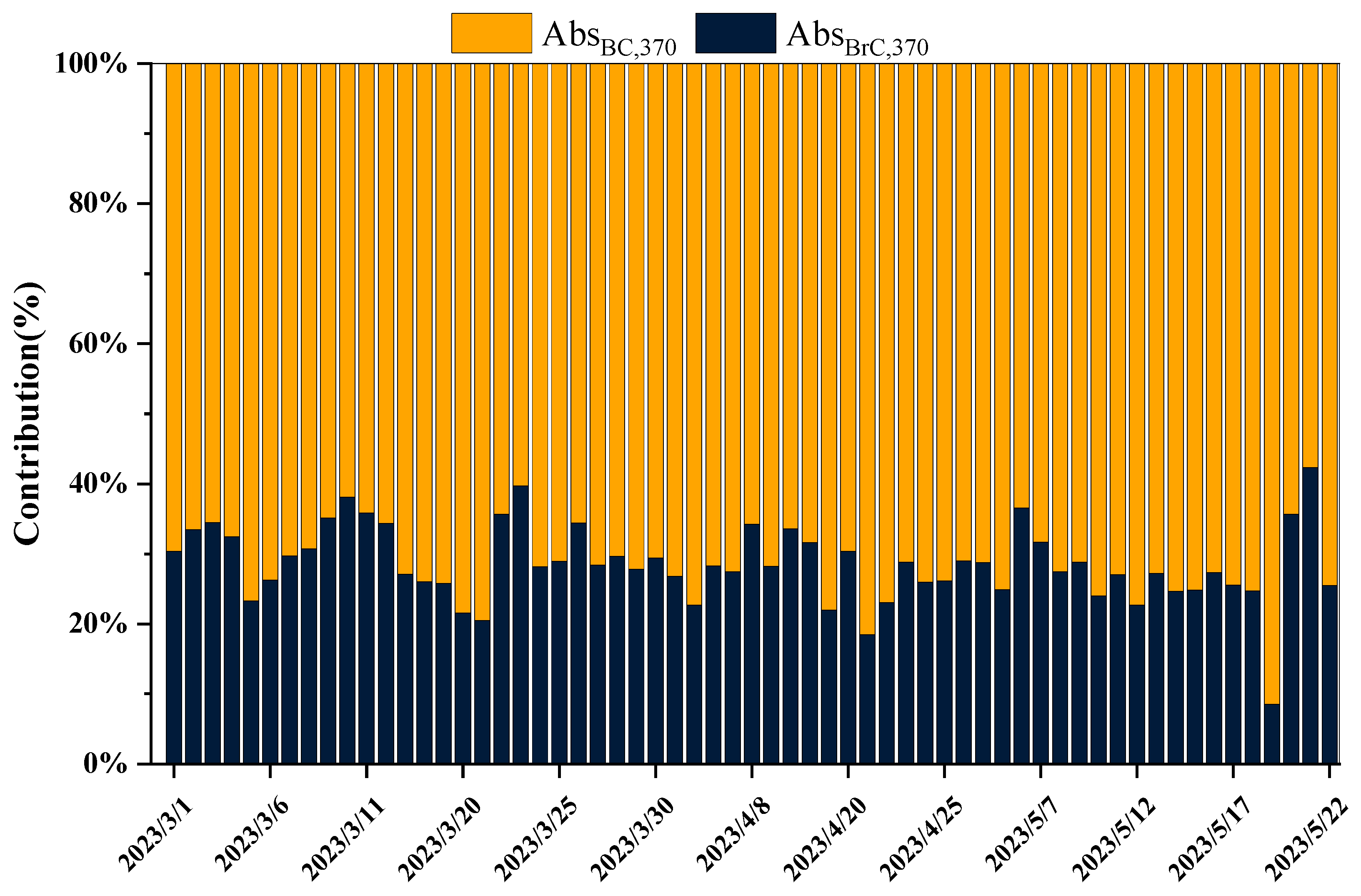
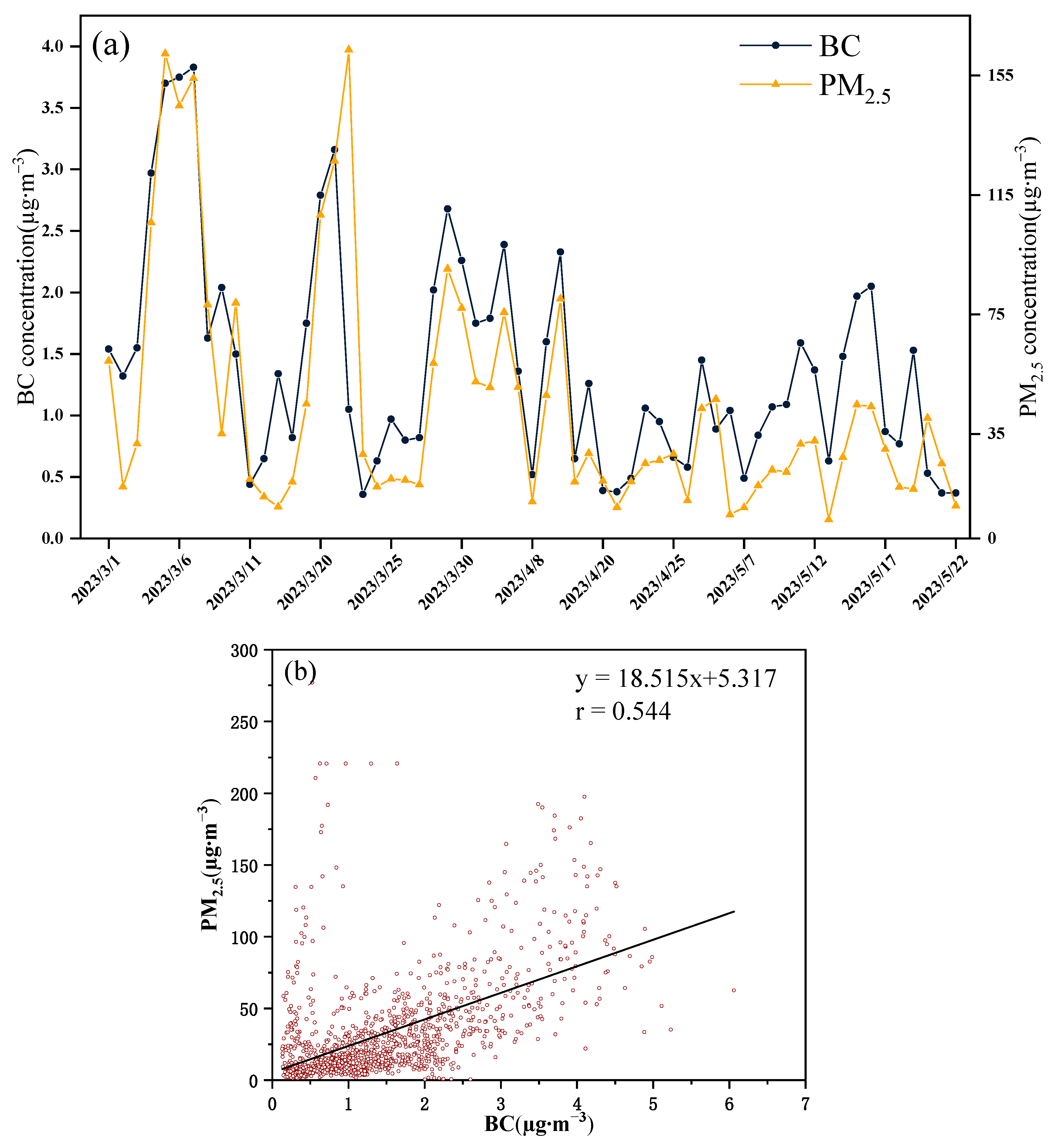


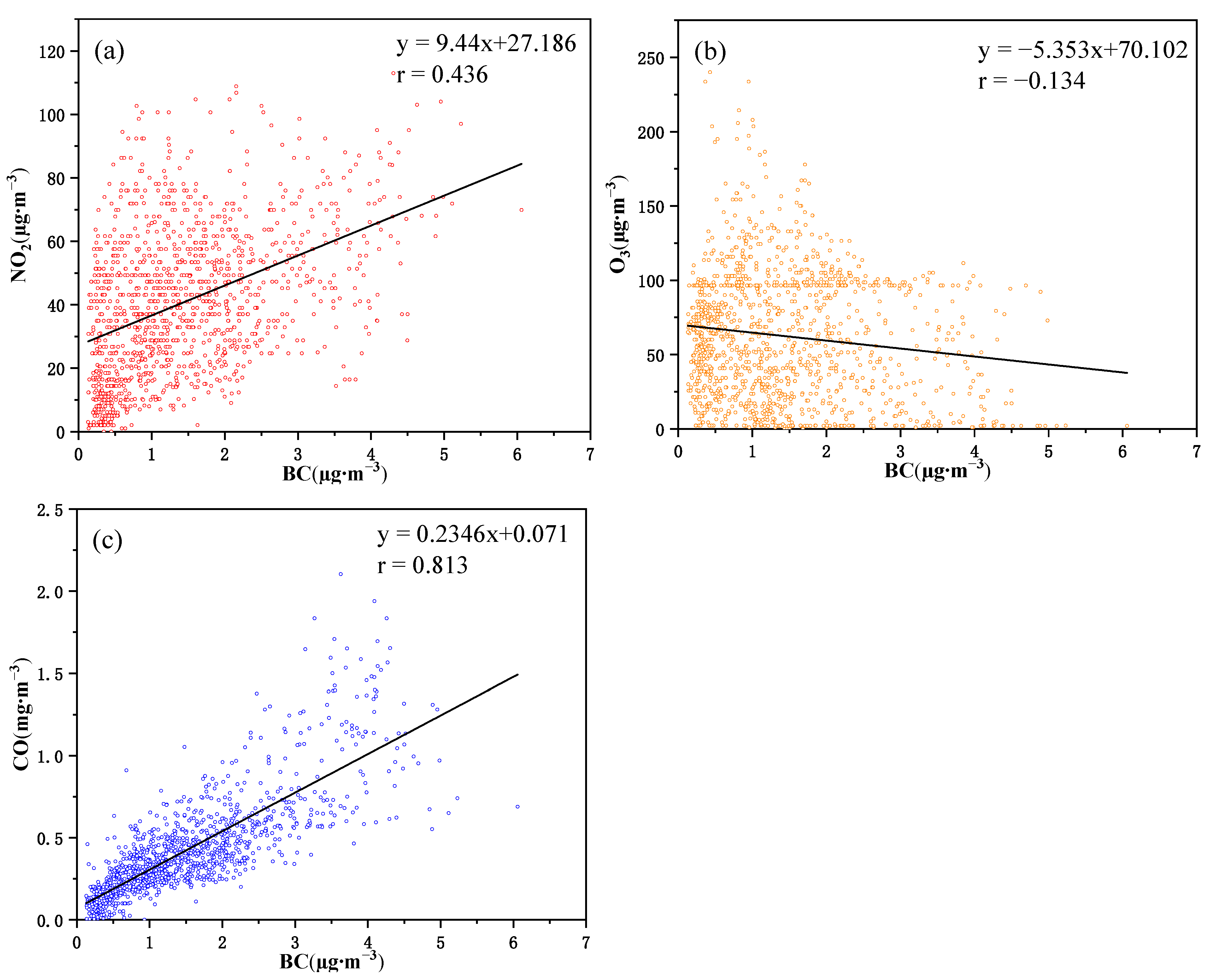
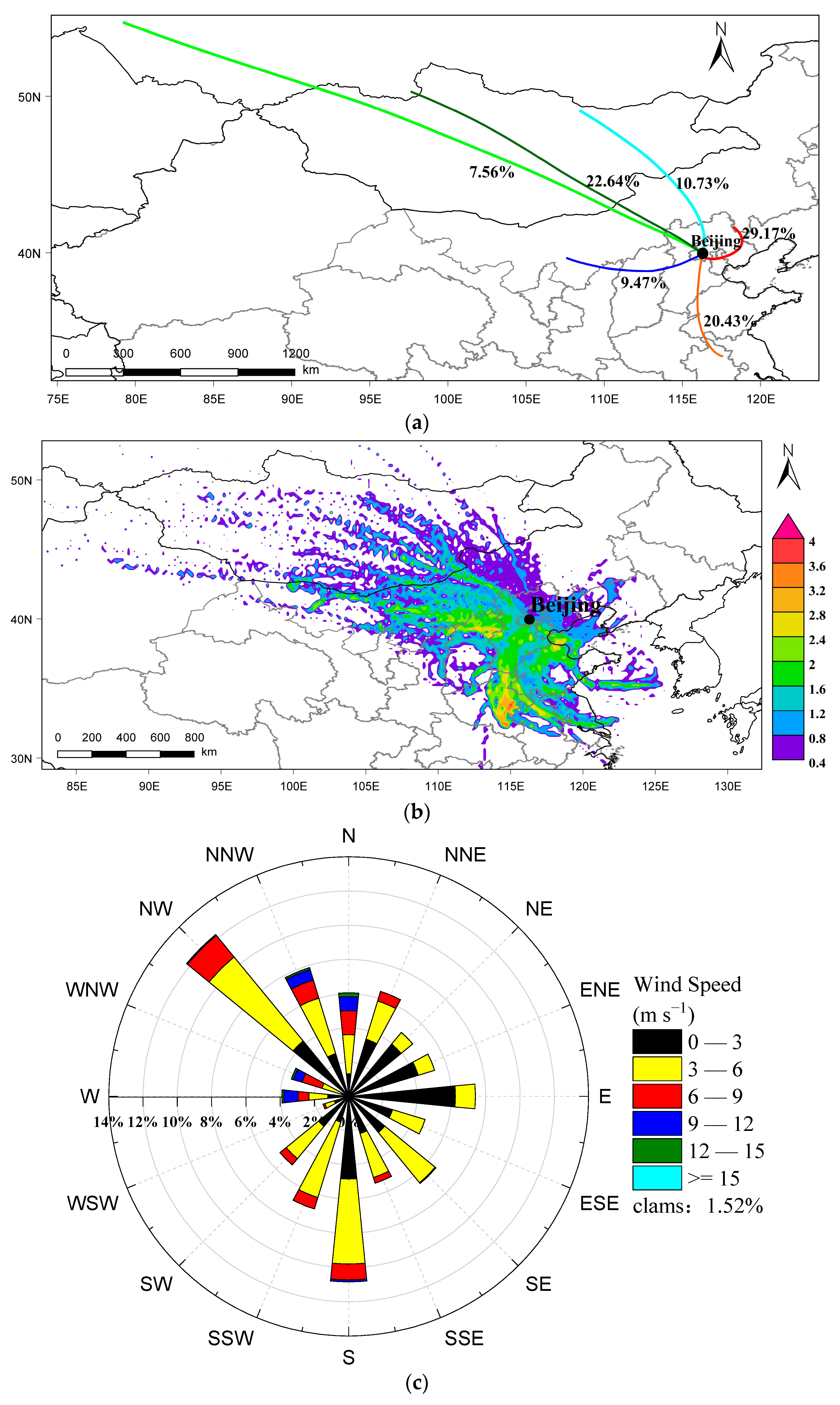
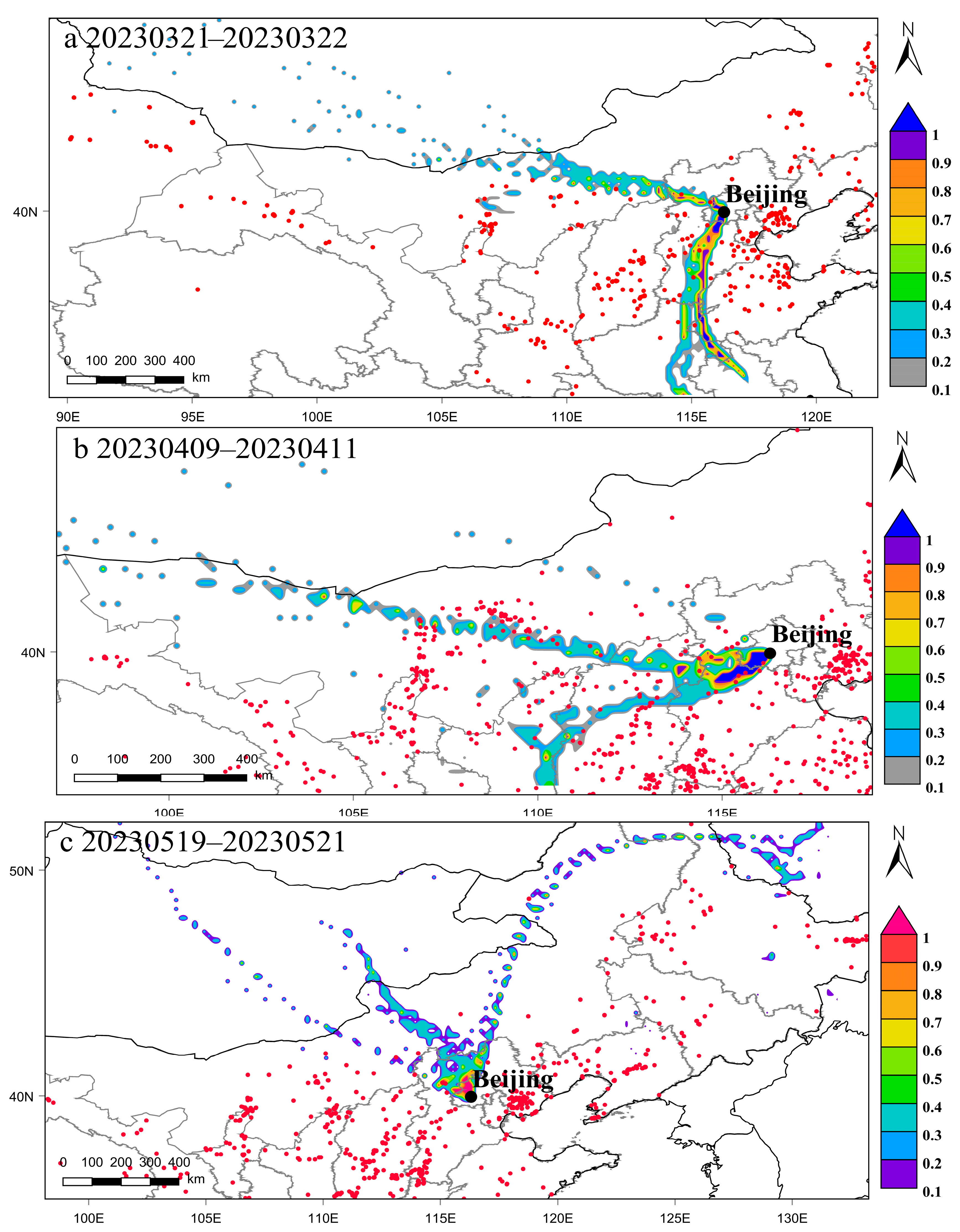
| Place | Observation Period | BC Concentration (μg∙m−3) | Study |
|---|---|---|---|
| Beijing, China | 2 March 2023 to 22 May 2023 | 1.39 ± 0.87 | This study |
| Xuzhou, China | Spring, 2014 | 3.308 | [4] |
| Nanjing, China | Spring, 2018 | 3.351 ± 0.919 | [27] |
| Chongqin, China | 17 January 2020 to 1 April 2020 | 3.8 ± 3.0 | [28] |
| Lanzhou, China | Spring, 2019 | 1.42 ± 0.63 | [22] |
| New Delhi, India | April to June 2016 | 6.33 | [29] |
| Mexico City, Mexico | April to June 2016 | 3.22 ± 1.54 | [9] |
Disclaimer/Publisher’s Note: The statements, opinions and data contained in all publications are solely those of the individual author(s) and contributor(s) and not of MDPI and/or the editor(s). MDPI and/or the editor(s) disclaim responsibility for any injury to people or property resulting from any ideas, methods, instructions or products referred to in the content. |
© 2024 by the authors. Licensee MDPI, Basel, Switzerland. This article is an open access article distributed under the terms and conditions of the Creative Commons Attribution (CC BY) license (https://creativecommons.org/licenses/by/4.0/).
Share and Cite
Lei, W.; Li, X.; Yin, Z.; Zhang, L.; Zhao, W. Pollution Characteristics and Source Apportionment of Black Carbon Aerosols during Spring in Beijing. Toxics 2024, 12, 202. https://doi.org/10.3390/toxics12030202
Lei W, Li X, Yin Z, Zhang L, Zhao W. Pollution Characteristics and Source Apportionment of Black Carbon Aerosols during Spring in Beijing. Toxics. 2024; 12(3):202. https://doi.org/10.3390/toxics12030202
Chicago/Turabian StyleLei, Wenkai, Xingru Li, Zhongyi Yin, Lan Zhang, and Wenji Zhao. 2024. "Pollution Characteristics and Source Apportionment of Black Carbon Aerosols during Spring in Beijing" Toxics 12, no. 3: 202. https://doi.org/10.3390/toxics12030202




